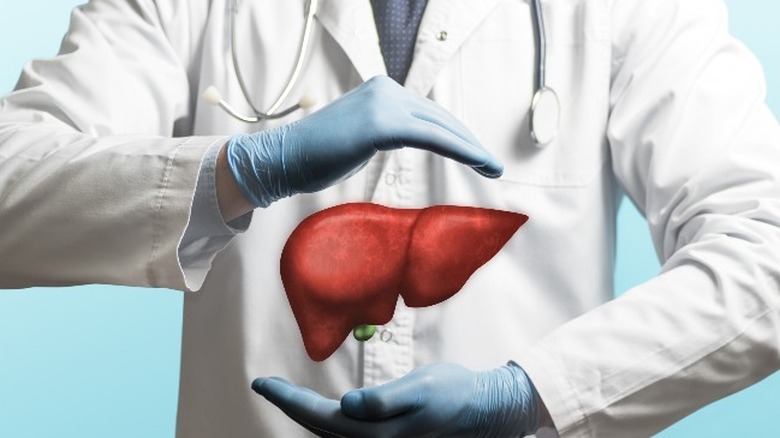What We Learned About Steve Jobs' Health After His Death
Steve Jobs was one of the most influential American businessmen in history. His ability to re-design the personal computer and the mobile phone with a sleek, innovative, user-friendly interface helped open up the world to new forms of culture and technology.
Generations to come, craning their collective necks to get a better look at the universe behind the screen, would embrace the "Think different" mantra that Jobs made synonymous with Apple products (per Harvard Business Review). Ever the innovator, Jobs often brought this progressive attitude to his lifestyle choices.
According to Business Insider, Jobs' diet mainly consisted of fruits and vegetables. He would also frequently fast for the mental benefits. Jobs also embraced an alternative approach to health care when he was diagnosed with a rare form of pancreatic cancer in 2003 (via ABC).
Many critics lamented Jobs' choices when it came to treating his cancer (per Forbes). They speculated that if he had stuck to a more traditional course of therapy, "He might still be alive today." Were they right — or was the story more complicated than that?
Steve Jobs' diagnosis
According to a 2012 article published in the journal of Preventive Medicine, Steve Jobs was diagnosed with a gastroenteropancreatic neuroendocrine tumor (GEP-NET) — also known as an islet cell tumor. The authors noted that this rarer form of pancreatic cancer is less aggressive than pancreatic adenocarcinoma, which can kill relatively quickly. More importantly, due to the slow-growing nature of the cancer, GEP-NETs may be cured if the tumor is removed before it spreads. Forbes says that Jobs' tumor was discovered via computerized tomography (CT) scan because his doctor was looking for kidney stones.
"Survival is measured in years, as opposed to pancreatic cancer, which is measured in months," said Leonard Saltz, a hematology specialist involved in neuroendocrine cancer research, when asked about Jobs' form of cancer (per Scientific American).
Dr. David Levi, professor of clinical surgery at the University of Miami Miller School of Medicine, told WebMD that surgery is the primary course of treatment for islet cell tumors. When faced with the option of surgery, Jobs explored alternative treatments.
Surgery and alternative medicine
According to ABC, Jobs delayed surgery on his tumor for about nine months. During that time, he pursued alternative medicines like acupuncture, botanicals, and dietary restrictions (via National Center for Biotechnology Information).
The authors of the 2012 article noted a few important facts about the type of cancer Jobs faced and the status of the medical field when he was diagnosed. First, there was limited clinical trial data on his type of tumor. Evidence for both conventional and alternative therapies were very limited. Jobs — like 43% to 67% of US cancer patients — made the choice to seek out alternative therapies after being diagnosed with cancer.
While Jobs made a non-traditional decision to seek alternative medicine, he was not alone. In fact, a 2019 study published in the Scandinavian Journal of Gastroenterology found that out of 186 patients with neuroendocrine tumors, some 66% took either vitamin and mineral supplements — like calcium and vitamin D — or non-vitamin/mineral supplements like fish oil.
Ultimately, Jobs elected to get the surgery, and reportedly regretted delaying it in the first place (via ABC). Dr. Maged Rizk, a gastroenterologist, commented on Jobs' choice to WebMD, saying "I don't think waiting nine months for surgery was a bad decision."
The Whipple procedure
In 2004, Jobs reportedly underwent a reconstructive surgery known as the Whipple operation (via Britannica). According to Mayo Clinic, the Whipple procedure — also referred to as a pancreaticoduodenectomy — is a risky and technically demanding surgery that is used to remove pancreatic tumors. Per WebMD, the Whipple procedure is the primary operation for an islet cell tumor that's positioned on the top of the "head of the pancreas."
The procedure involves the removal of many internal structures, including the head of the pancreas, and parts of the bile duct, gallbladder, and the beginning of the small intestine (via WebMD). Then, the remainder of the organs is reattached to the small intestine. This enables the patient to digest food post-surgery, says Mayo Clinic.
WebMD says that this surgery is particularly risky because of the risk of infection, internal bleeding, and abnormal connections between body parts. Unfortunately, Jobs was not out in the clear for long, and found himself back on the operating table a few years later.
Steve Jobs' liver transplant
In 2009, Jobs released information that his notable weight loss was due to a hormone imbalance (per CNN). Mayo Clinic says that neuroendocrine tumors may release excess hormones. Dr. Jeffrey Mechanick, a clinical professor at Mount Sinai Medical Center, stated that the recurrence of Jobs' cancer could lead to the overproduction of hormones like glucagon and result in weight loss.
According to ABC, Steve Jobs subsequently traveled to Tennessee to undergo a liver transplant operation. This decision left many wondering the same thing: Why?
When neuroendocrine tumors spread only to the liver, some cases can be successfully treated (and even cured) with a liver transplant (per WebMD). However, Levi further cautioned that the transplant did not guarantee a clean bill of health, and that the cancer could reoccur.
While some wondered why Jobs underwent a liver transplant, others questioned if he had "cut the line" and bought his way to the top of the donor list (via CNN). But a press release from the Methodist University Hospital Transplant Institute — the center where the surgery was performed — stated that "he [Jobs] received a liver transplant because he was the patient with the highest MELD score (Model for End-Stage Liver Disease) of his blood type and, therefore, the sickest patient on the waiting list at the time a donor organ became available."
Jobs returned to work shortly after the operation (via ABC).
Peptide receptor radionuclide therapy
In 2009 — the same year that he had the liver transplant — Fortune reported that Jobs also traveled to Switzerland to receive an experimental treatment during his medical leave of absence. It is unclear if this treatment preceded the liver transplant operation.
According to ABC, Jobs received peptide receptor radionuclide therapy (PRRT). Per National Cancer Institute, peptide receptor radionuclide therapy (PRRT) involves the injection of a radioactive peptide. The therapy helps treat forms of neuroendocrine tumors by targeting and killing cancer cells while leaving the healthy cells unharmed. While the therapy was listed as experimental at the time, ABC reported that specialists thought the treatment was effective for neuroendocrine cancers; and that eventually, the U.S. Food and Drug Administration (FDA) would approve peptide receptor radionuclide therapy (PRRT).
In 2018, National Cancer Institute reported that the U.S. Food and Drug Administration (FDA) approved peptide receptor radionuclide therapy (PRRT) — brand name Lutathera® — for the treatment of adult patients with advanced gastroenteropancreatic neuroendocrine tumors (GEP-NET). Mayo Clinic currently cites the therapy as a treatment for "advanced neuroendocrine tumors."
In late 2011, Jobs passed away at 56 years old, eight years after his initial diagnosis (via Pancreatic Cancer Action Network). Before his death, Jobs was thanked by the Carcinoid Cancer Foundation for raising awareness of neuroendocrine cancers.






